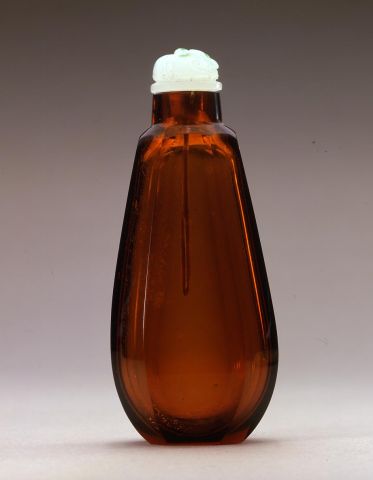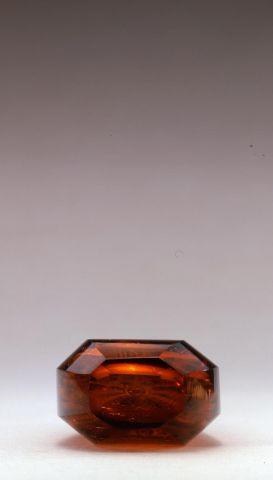

Bottle ID: 00109
RED AMBER, ELONGATED OCTAGONAL, FACETED W/CRIZZLING
Date: 1730-1800
Height: 70 mm
Glass, of amber-red tone, and of elongated octagonal faceted form, tapering to a cylindrical neck, the base of an octagonal shape, the clear glass crizzled throughout, in imitation of amber.
Imperial, attributed to the Palace Workshops, Beijing.
Similar Examples:
Crane Collection no. 288.
Crane Collection nos. 343, 444 and 724
Lawrence, Clare. Miniature Masterpieces from the Middle Kingdom - The Monimar Collection of Chinese Snuff Bottles, 1996, pp. 220-221, no. 104.157.
Zhang Rong, Luster of Autumn Water - Glass of the Qing Imperial Workshop, 2005, p. 137, no. 15.
Provenance:
Clare Lawrence Ltd.
Exhibited:
Annual Convention ICSBS Toronto, October 2007
The National Palace Museum in Beijing houses a small clear amber colored glass water container of squat hexagonal faceted form with an incised Yongzheng nianzhi mark on the base. It is catalogued as being light orange in color, but is clearly an amber color. This suggests that amber colored glass was an early favorite of the Palace Workshops that continued as a color until the mid-nineteenth century. The Archives of the National Palace Museum in Beijing list both 'amber' and 'golden amber' as colors used during the Qianlong period. On two occasions in 1776, the Zaobanchu ordered one pair of amber glass dishes, intended for bestowal, to be sent to the leather and tailor workshop, presumably to have some kind of bag made for them. (Archive No. 3596). Later in 1776, a memorandum in the Archives lists the following golden amber glass items as miscellaneous items in the Changchun yuan: a dish, a flower vase, a set of ten dishes, a set of eighteen dishes and a further set of twelve dishes. In the same memorandum, the following objects are listed as "large and heavy items, rejected and broken items in the Changchun yuan": twenty amber colored dishes, a further three amber colored dishes and four golden amber Gu-beakers. (Archive No. 3597).
It is difficult to perceive all amber colored glass objects, whether they are snuff bottles or not, being made in imitation of natural amber since the form of these objects are often highly contrived, and could not resemble the equivalent object in amber. This snuff bottle with its faceted form cannot be said to imitate an amber snuff bottle, although the extensive interior crizzling lends itself to an obvious comparison with the natural material. Since crizzling occurs when the proportion of alkali in the glass mixture is incorrect, it is impossible to know whether in this case it was deliberate or simply a fortuitous accident.

 English
English 中文
中文